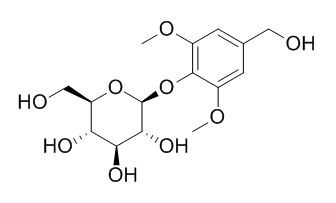Di-O-methylcrenatin
Standard reference
Inquire / Order:
manager@chemfaces.com
Technical Inquiries:
service@chemfaces.com
Tel:
+86-27-84237783
Fax:
+86-27-84254680
Address:
1 Building, No. 83, CheCheng Rd., Wuhan Economic and Technological Development Zone, Wuhan, Hubei 430056, PRC
Providing storage is as stated on the product vial and the vial is kept tightly sealed, the product can be stored for up to
24 months(2-8C).
Wherever possible, you should prepare and use solutions on the same day. However, if you need to make up stock solutions in advance, we recommend that you store the solution as aliquots in tightly sealed vials at -20C. Generally, these will be useable for up to two weeks. Before use, and prior to opening the vial we recommend that you allow your product to equilibrate to room temperature for at least 1 hour.
Need more advice on solubility, usage and handling? Please email to: service@chemfaces.com
The packaging of the product may have turned upside down during transportation, resulting in the natural compounds adhering to the neck or cap of the vial. take the vial out of its packaging and gently shake to let the compounds fall to the bottom of the vial. for liquid products, centrifuge at 200-500 RPM to gather the liquid at the bottom of the vial. try to avoid loss or contamination during handling.
J Ethnopharmacol.2018, 210:88-94
Pharmaceutics.2021, 13(7):1028.
Evid Based Complement Alternat Med.2017, 2017:6360836
Ecol Evol.2022, 12(11):e9459.
Neurochem Int.2018, 121:114-124
J Hepatocell Carcinoma.2022, 9:327-341.
Food Engineering Progress2019, 23(3)209-216
Front Pharmacol.2017, 8:673
Int J Biol Sci.2023, 19(10):3077-3098.
Korean J Dent Mater.2018, 45(2):139-146
Related and Featured Products
Fitoterapia. 2012 Jan;83(1):130-6.
Iridoid, phenylethanoid and flavonoid glycosides from Sideritis trojana.[Pubmed:
22024633 ]
METHODS AND RESULTS:
From the MeOH extract of Sideritis trojana, a new iridoid glycoside, 10-O-(E)-feruloylmelittoside (1) was obtained in addition to four known iridoid glycosides [melittoside (2), 10-O-(E)-p-coumaroylmelittoside (3), stachysosides E (4) and G (5)]. Moreover, five phenylethanoid glycosides [verbascoside (6), isoacteoside (7), lamalboside (8), leonoside A (9), isolavandulifolioside (10), three flavone glycosides (isoscutellarein 7-O-[6'''-O-acetyl-β-allopyranosyl-(1→2)]-β-glucopyranoside (11), 4'-O-methyisoscutellarein 7-O-[6'''-O-acetyl-β-allopyranosyl-(1→2)]-β-glucopyranoside (12), 3'-hydroxy-4'-O-methyisoscutellarein 7-O-[6'''-O-acetyl-β-allopyranosyl-(1→2)]-β-glucopyranoside (13) and a benzylalcohol derivative (Di-O-methylcrenatin) were obtained and identified. The structures were elucidated on the basis of NMR and HRMS data.
CONCLUSIONS:
All compounds were tested for their antioxidant activity by in vitro TEAC assay and some of them exhibited moderate activity (0.97-1.44 mM) when compared with the reference compound (quercetin 1.86 mM). Glycosides 6-13, the most active compounds in the TEAC assay, were also tested by flow cytometry to evaluate their ability to affect the levels of reactive oxygen species (ROS) in human prostate cancer cells (PC3).
Fitoterapia. 2013 Jul;88:38-43.
Alkyl and phenolic glycosides from Saussurea stella.[Pubmed:
23567860]
METHODS AND RESULTS:
Their structures were elucidated by NMR, MS, UV, and IR spectroscopic analysis. Of the known compounds, (+)-medioresinol-di-O-β-D-glucoside (7), picraquassioside C (10), and diosmetin-3'-O-β-D-glucoside (27) were isolated from the Asteraceae family for the first time, while (+)-pinoresinol-di-O-β-D-glucoside (6), Di-O-methylcrenatin (11), protocatechuic acid (14), 1,5-di-O-caffeoylquinic acid (17), formononetin (28), and phenethyl glucoside (29) were isolated from the Saussurea genus for the first time. The anti-inflammatory activities of three new compounds (1-3), five lignans ((-)-arctiin (4), (+)-pinoresinol-4-O-β-D-glucoside (5), (+)-pinoresinol-di-O-β-D-glucoside (6), (+)-medioresinol-di-O-β-D-glucoside (7) and (+)-syringaresinol-4-O-β-D-glucoside (8)), one neolignan (picraquassioside C (10)), and one phenolic glycoside (Di-O-methylcrenatin (11)) were evaluated by testing their inhibition of the release of β-glucuronidase from PAF-stimulated neutrophils.
CONCLUSIONS:
Only compound 5 showed moderate inhibition of the release of β-glucuronidase, with an inhibition ratio of 39.1%.



